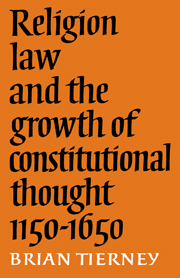Book contents
- Frontmatter
- Contents
- Dedication
- Preface
- I Introduction
- II Juridical foundations: society, church, and law, 1150–1250
- III Origins of jurisdiction: hierarchy and consent, 1250–1350
- IV Popular sovereignty, federalism, and fundamental law: Azo to Althusius
- V Corporate rulership and mixed constitution
- VI Conclusion
- Select bibliography
IV - Popular sovereignty, federalism, and fundamental law: Azo to Althusius
Published online by Cambridge University Press: 23 February 2010
- Frontmatter
- Contents
- Dedication
- Preface
- I Introduction
- II Juridical foundations: society, church, and law, 1150–1250
- III Origins of jurisdiction: hierarchy and consent, 1250–1350
- IV Popular sovereignty, federalism, and fundamental law: Azo to Althusius
- V Corporate rulership and mixed constitution
- VI Conclusion
- Select bibliography
Summary
In this lecture I want to discuss some stages in the development of the interrelated ideas that I have called ‘popular sovereignty’, ‘federalism’, and ‘fundamental law’ from the thirteenth century to the seventeenth. The argument begins with some scattered remarks of the Roman lawyer, Azo, and ends with the complex synthesis of Althusius. In between, the fifteenth-century conciliarists had shaped theories of church government that (as Figgis long ago pointed out) would eventually prove applicable to political societies in general.
Let us introduce the subject with some words from a founder of modern federalism. James Madison wrote: ‘A dependence on the people is no doubt the primary control on government; but experience has taught mankind the necessity of auxiliary precautions.’ The ‘auxiliary precautions’ have often included a diffusion of authority designed to prevent any one man from wielding absolute despotic power, and a structure of constitutional law intended to bind the government itself. The diffusion of authority can take many forms, described in phrases that had become common by the seventeenth century as ‘double sovereignty’, ‘dual majesty’, ‘mixed government’, ‘mixed monarchy’, ‘limited monarchy’. Anyone who has studied Gierke's sometimes sibylline utterances on these matters will know how complex they can become. But there are two broad patterns of diffusion that commonly recur: a diffusion of authority between central government and local governments regulated by a fundamental law, a system of ‘federalism’; and diffusion of authority within the central government itself, a system of ‘checks and balances’. The two systems are not mutually exclusive of course; the American constitution combines both.
- Type
- Chapter
- Information
- Publisher: Cambridge University PressPrint publication year: 1982



